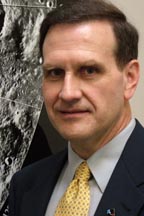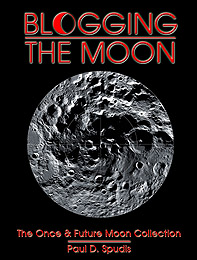| | NASA has been in the news lately for reasons beyond the exciting discoveries of various and vast quantities of water on the Moon. Unfortunately, the long, drawn out repositioning of our national space program has brought the space community to loggerheads, leaving the future of the U.S. manned space program in jeopardy. The upheaval caused by fights over rocket designs and suppliers, and the “Eenie, meenie, minie, moe” formula being used to select our new space direction, has placed the U.S. space program in peril. | AVAILABLE NOW! $27.95 plus shipping Go to Item #27A on the shopping cart. Comes with exclusive DVD-Video of Dr Spudis revealing the latest on lunar exploration! ISBN 9781926837178 | ||||
To contact us email hereApogee Prime is a member of the Griffin Media Group© 2010 Griffin Media |
 | Paul D. Spudis is a Senior Staff Scientist at the Lunar and Planetary Institute in Houston, Texas. He was formerly with the Branch of Astrogeology, U. S. Geological Survey in Flagstaff, Arizona and the Applied Physics Laboratory in Laurel MD. He is a geologist, educated at Arizona State University (B.S., 1976), Brown University (Sc.M., 1977), and Arizona State University (Ph.D., 1982.) Since 1982, he has specialized in research on the processes of impact and volcanism on the planets and studies of the requirements for sustainable human presence on the Moon. He has served on numerous panels and groups advisory to NASA, including the Committee for Planetary and Lunar Exploration (COMPLEX) of the National Academy of Sciences and the Synthesis Group, a special panel of the Executive Office of the President that in 1990-1991, analyzed a return to the Moon to establish a base and the first human mission to Mars. He was Deputy Leader of the Science Team for the Department of Defense Clementine mission to the Moon in 1994 and Principal Investigator of Mini-SAR, an imaging radar experiment on the Indian Chandrayaan-1 mission that orbited and mapped the Moon in 2008-2009. He was a member of the President’s Commission on the Implementation of U. S. Space Exploration Policy, whose report was issued June, 2004 and in September 2004, was presented with the NASA Distinguished Public Service Medal for his work on that body. He is the recipient of the 2006 Von Karman Lectureship in Astronautics, awarded by the American Institute for Aeronautics and Astronautics. He is the author or co-author of over 100 scientific papers and five books, including The Once and Future Moon, a 1996 book for the general public as part of the Smithsonian Institution Library of the Solar System series, and (with Ben Bussey) The Clementine Atlas of the Moon, published in 2004 by Cambridge University Press. |

